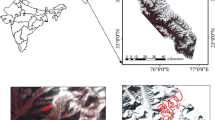Abstract
Detection, monitoring and precise assessment of the snow covered regions is an important issue. Snow cover area and consequently the amount of runoff generated from snowmelt have a significant effect on water supply management. To precisely detect and monitor the snow covered area we need satellite images with suitable spatial and temporal resolutions where we usually lose one for the other. In this study, products of two sensors MODIS and ASTER both on board of TERRA platform having low and high spatial resolution respectively were used. The objective of the study was to modify the snow products of MODIS by using simultaneous images of ASTER. For this, MODIS snow index image with high temporal resolution were compared with that of ASTER, using regression and correlation analysis. To improve NDSI index two methods were developed. The first method generated from direct comparison of ASTER averaged NDSI with those of MODIS (MODISI). The second method generated by dividing MODIS NDSI index into 10 codes according to their percentage of surface cover and then compared the results with the difference between ASTER averaged and MODIS snow indices (SCMOD). Both methods were tested against some 16 MODIS pixels. It is found that the precision of the MODISI method was more than 96%. This for SCMOD was about 98%. The RMSE of both methods were as good as 0.02.












Similar content being viewed by others
References
Barnett, T. P., DüMenil, L., Schlese, U., Roeckner, E. R., & Latif, M. (1989). The effect of Eurasian snowcover on regional and global climate variations. Journal of Atmospheric Sciences, 46(5), 661–686.
Carrol, T. R. (1995). Remote sensing of snow in cold region. Proceedings of the first moderate resolution imaging specteroradiometer (MODIS). Snow and ice workshop, Sept. 13–14, 1995, pp 65–72.
Cess, R. D., Potter, G. L., Zhang, M. H., Blanchet, J. P., Chalita, S., Colman, R., et al. (1991). Interpretation of snow-climate feedback as produced by 17 general circulation models. Science, 253, 888–892.
Cohen, J., & Entekhabi, D. (2001). The influence of snow cover on Northern Hemisphere climate variability. Atmosphere-Ocean, 39(1), 35–53.
Hall, D. K., & Riggs, G. A. (2007). Accuracy assessment of the MODIS snow products. Wiley Interscience, 21, 1534–1547.
Hall, D. K., Riggs, G. A., & Salomonson, V. V. (1995). Development of methods for mapping global snow cover using moderate resolution imaging spectroradiometer data. Remote Sensing of Environment, 54, 127–140.
Hall, D. K., Riggs, G. A., & Salomonson, V. V. (2001). Algorithm Theoretical Basis Document (ATBD) for the MODIS snow and sea ice-mapping algorithms. Hydrological Science Branch NASA. http://modis-snow-ice.gsfc.nasa.gov/atbd.html.
Javadnia, E., Mobasheri, M. R., & Kamali, G. (2009). MODIS NDVI quality enhancement using ASTER images. Journal of agricultural science and technology, 11, 549–558.
Jones, H. G. (1999). The ecology of snow-covered systems: A brief overview of nutrient cycling and life in the cold. Hydrological Processes, 13, 2135–2147.
Klein, A. G., & Barnett, A. C. (2003). Validation of daily MODIS snow cover maps of Upper Rio Grande river basin for the 2000–2001 snow year. Remote Sensing of Environment, 86, 162–176.
Konig, M., Winther, J. G., & Isaksson, E. (2001). Measuring snow and glacier ice properties from satellite. Reviews of Geophysics, 39(1), 1–27.
Kulkarni, A. V., Srinivasulu, J., Manjul, S. S., & Mathur, P. (2002). Field based spectral reflectance studies to develop NDSI method for snow cover monitoring. Journal of the Indian Society of Remote Sensing, 30(1 and 2), 73–80.
Liang, T. G., Huang, X. D., Wu, C. X., Liu, X. Y., Li, W. L., Gao, Z. G., et al. (2007). An application of MODIS data to snow cover monitoring in a pastoral area: a case study in Northern Xinjiang, China. Remote Sensing of Environment, 112(4), 1514–1526.
Marks, D., Kimball, J., Tingey, D., & Link, T. (1998). The sensitivity of snowmelt processes to climate conditions and forest cover during rain on snow: a case study of the 1996 Pacific Northwest flood. Hydrological Processes, 12(10–11), 1569–1587.
Mobasheri, M. R. (2006). Fundamentals of physics in remote sensing and satellite technology (Farsi Ed.). KNToosi University of Technology Publication, Tehran, Iran.
Mobasheri, M. R., & Rezaie, Y. (2007). Differentiating between low clouds and fog cover using MSG-1. Journal of Engineering Faculty Tehran University, 40(8), 13–23.
Salomonson, V. V., & Appel, I. (2006). Development of the aqua MODIS NDSI fractional snow cover algorithm and validation results. IEEE Transactions on Geoscience and Remote Sensing, 44(7), 1747–1756.
Salomonson, V. V., & Mao, J. (2004). A sensivity analysis of the MODIS normalized difference snow index. Remote Sensing Symposium. IGARSS 2004: IEEE International Geoscience and Remote Sensing Symposium Proceedings, Vols 1–7 - Science for Society: Exploring and Managing a Changing Planet, 3717–3720.
Sorteberg, H. K., Engeset, R. V., & Udnæs, H. C. (2001). A national network for snow monitoring in Norway: snow pillow verification using observations and models. Physics and Chemistry of the Earth, Part C: Solar–Terrestial and Planetary Science, 26(10–12), 723–729.
Srinivasulu, J., & Kulkarni, A. V. (2004). Estimation of spectral reflectance of snow from IRS-1D LISS-III sensor over the Himalayan terrain. Indian Academy of Science (Earth and Planetary Science), 113(1), 117–128.
Sui, J., & Koehler, G. (2001). Rain-on-snow induced flood events in Southern Germany. Journal of Hydrology, 252, 205–220.
Vikhamer, D., & Solberg, R. (2002). Subpixel mapping of snow cover in forests by optical remote sensing. Remote Sensing of Environment, 84, 69–82.
Vikhamar, D., & Solberg, R. (2003). Snow-cover mapping in forests by constrained linear spectral unmixing of MODIS data. Remote Sensing of Environment, 88, 309–323.
Walker, D. A., Halfpenny, J. C., Walker, M. D., & Wessman, C. (1993). Long-term studies of snow—snow interactions. Bioscience, 43, 281–301.
Author information
Authors and Affiliations
Corresponding author
About this article
Cite this article
Mobasheri, M.R., Shafizadeh Moghadam, H. & Shayan, S. An Introduction to MODISI and SCMOD Methods for Correction of the MODIS Snow Assessment Algorithm. J Indian Soc Remote Sens 38, 674–685 (2010). https://doi.org/10.1007/s12524-011-0082-6
Received:
Accepted:
Published:
Issue Date:
DOI: https://doi.org/10.1007/s12524-011-0082-6




